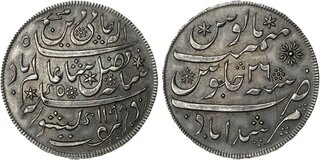| Classical Numismatic Group > Triton XXVII | Auction date: 9 January 2024 |
| Lot number: 1146 Price realized: 35,000 USD (Approx. 32,057 EUR) Note: Prices do not include buyer's fees. | Show similar lots on CoinArchives Find similar lots in upcoming auctions on |
| Lot description: INDIA, Colonial. British India. Bengal Presidency. 1699-1835. AR Pattern Double Rupee (34mm, 23.51 g, 6h). Prinsep's coinage. In the name of Shah 'Alam II (AH 1173-1221 / 1759-1806). Murshidabad (Pulta) mint. Triply dated AH 1198, RY 26 of Shah Alam II, and 1784. sikka zad bar haft kishwar saya fazl ilah hami din muhammad shah alam badshah 1198 / zarb murshidabad sanah 19 julus maimanat manus. Edge: UNITED EAST INDIA COMPANY 1784 (six-ray star stops). CEEIC 3.1; Pridmore 346; KM Pn9. Richly toned. In NGC encapsulation 6382530-002, graded PF 63. A most impressive coin. A great rarity of the Indian series. Ex Robert P. Puddester Collection; F. Pridmore Collection (Part II, Glendining, 18 October 1982), lot 674. John Prinsep (1748-1830) was the son of an Oxfordshire vicar. Seeing few opportunities for advancement in England, he joined the East India Company as a cadet, landing in Bombay in 1771. It appears that the young Prinsep soon decided to abandon his army career in favour of the commercial opportunities India offered him; he never joined the Company's army and resigned his commission in 1772. Having worked for several London cloth merchants before leaving for India, Prinsep soon became involved in the East India Company's cotton trade. In 1779, Prinsep began to cultivate and manufacture indigo in Nilgang, and while it appears this venture was profitable from the outset, events on the other side of the world would lead to Prinsep making his fortune. During the second half of the eighteenth century, one of the main sources of indigo was the plantations of South Carolina, so that indigo dye accounted for more than one-third of the value of all exports from the American colonies. The outbreak of the American War of Independence disrupted this trade at exactly the moment when Prinsep began producing indigo at Nilgang, allowing Indian producers to take control of this highly lucrative market. Following the discovery of copper mines at Rotasgarh, in 1780 Prinsep secured a contract to strike copper coins at a mint which he established in Pulta. In 1784, Prinsep tried to persuade the Calcutta Board to let him issue a new silver and gold coinage for Bengal, pointing out that the equipment in use at his new mint in Pulta was superior to what was then in use at the Calcutta mint. Following the resignation in January 1785 of the Calcutta mint master, James Paxton, it appears that Prinsep produced a small number of pattern coins dated 1784, including the present piece. Prinsep sent these to the Court of Directors in London in an attempt to persuade them to appoint him as the new mint master, but was unsuccessful. This setback hardly hindered Prinsep, however, who returned to England in 1788 having amassed a colossal fortune. He went on to pursue an active political career, including serving as MP for Queenborough from 1802-6, before his death at an advanced age in 1830. Estimate: 20000 USD |  |



